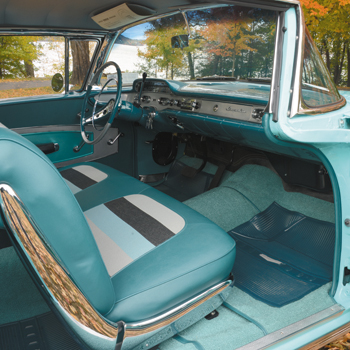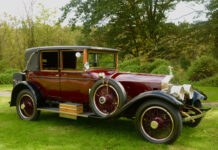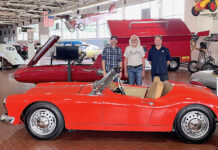By Jay Hirsch
The 1958 Chevrolet was so new it even had a change of name for its models. The 210 was now the Biscayne, while the Del Ray, formerly the 150, and the Bel Air, which was the top of the line, now had two upscale additions, the Impala two-door hardtop and an Impala convertible.
Not only were there new names, but the body and frame were entirely new, and the design of the Chevrolet was completely different than the 1957. The chassis was now an X-frame, similar to what Cadillac introduced in 1957. The underbody, which mounted to the frame, was heavily reinforced and stiffened by the extension of body rocker panels up to the dashboard. In the rear, the axle was attached to the frame at four points. This four-link-suspension was made possible by using coil springs in the rear, the first time Chevrolet used coil springs.
Air suspension was an option that fortunately not too many opted for. The air suspension did not offer much improvement in the ride and handling compared to conventional springing, plus a greater expense and some inherent problems.
In addition to the inline 235 cid six-cylinder engine and the 283 cid V-8, Chevrolet had a new 348 cid V-8 motor with a four-barrel carburetor. There also was a 3-2 bbls option on this engine.
As with almost every car made by the Big Three in 1958, the Chevrolet now had dual headlights. This was done, it was said, “to improve night visibility.” It was also said by some to be “just a styling design.” If you ever see a 1958 Chevtolet or a 1958 Cadillac, stand about 15 feet back from the front of the car and take a look at the four headlights. The inner headlights are slightly lower and at a angle from the outer headlights. This is pure design. It gives the front of the car dimension and a more pleasing look.
The car seen here was given a complete, painstaking, frame-off restoration by its owner, Bob Sekelsy, who is an artist and a designer for HBO. Bob also has an original (as in not restored) 1959 Chevrolet two-door which has won numerous awards at AACA meets.
This 1958 Impala came to Bob’s attention in 2003. A solid car with no rust, it was beyond “original,” being in good original condition.
“Patina is one thing; shabby is something else,” Bob said.
The paint was faded, Bob said, “faded so much you saw more primer where there was once paint than paint  on the car. The interior was either ripped in places, dry rotted and just basically neglected. I always thought that of the Chevy’s from 1955 to 1960, the 1958 Impala was the best looking. With its 1950s pastel colors of Tropic Turquoise and Snowcrest White and the 348 V-8 as icing on the cake, I knew this was the car for me, even though it would need much work and time. The car was registered and was very drivable when I bought it, but cosmetically it was in need of a face and body lift. It was too bad that the car was neglected, because I got the impression that up until ten or twelve years before I got the car, it was a nice original as opposed to a not-nice original when I saw it.”
on the car. The interior was either ripped in places, dry rotted and just basically neglected. I always thought that of the Chevy’s from 1955 to 1960, the 1958 Impala was the best looking. With its 1950s pastel colors of Tropic Turquoise and Snowcrest White and the 348 V-8 as icing on the cake, I knew this was the car for me, even though it would need much work and time. The car was registered and was very drivable when I bought it, but cosmetically it was in need of a face and body lift. It was too bad that the car was neglected, because I got the impression that up until ten or twelve years before I got the car, it was a nice original as opposed to a not-nice original when I saw it.”
The first thing Bob did after getting home and putting the Impala in his four-car garage was to begin a three-month-long process of disassembling the car and cataloging each part as he placed them in clear plastic bags with the name of each item and where it came from.
“I was going to give myself six years to do the work,” Bob said.
He meant that he was gong to do all the work himself along with some help from his brother Andy. This was to be done on weekends and during other times when there was free time. Bob also had a life to live and was not going to devote every minute of that life to the Impala. Bob also had the 1959 Chevy which he enjoyed driving, in addition to a 1959 Oldsmobile four door hardtop. Being an artist, Bob understands all too well the properties of old paint and new paint, be it paint for the canvas of an artist or painting a car.
What was planned for a six-year project turned into seven and half years The engine was rebuilt and all mechanical and trim components were either rebuilt by Bob or NOS parts were used when needed and available.
As for the painting of the car, there was more than enough original paint on the roof and inside of the trunk for Bob to match up the with new paints used today.
“It took me about five hours of adding small amounts of tint to get the right shades of color,” Bob said. “All paint codes do is tell you where to begin. Then, depending on the base paint in the can to which you add your color, you now have a foundation to build upon. I bought twice as much base cans of paint as I needed. Who knows what the future holds? If I had to repaint part or all of the car sometime, the colors will be the same.”
After several times of mixing paint, spraying part of the car, letting the paint dry, Bob achieved the shade of turquoise and shade of white that matched the original colors. Bob was not going for a “show car” or, as he says, a “showy car.” The engine compartment is as it was when new, no shiny black paint on the inner fenders or anywhere else under the hood. His original 1959 Chevrolet was used as model for an example of what an original engine bay should look like.
As for how good a job Bob did, the Impala took a Junior the first time it was judged at the AACA Hershey, Pa., fall meet and has gone onto to win a Senior and then Preservation award. All this on a car that has never been a “trailer queen”!
“I built this 1958 Impala to drive, and that is what I do with it, just as I do with all my cars,” Bob said. “As for the ride, at 75 mph on today’s highways, the miles just melt away. You have 360-degree visibility with all the glass, and there are no blind spots, besides having a trunk with a full-size tire and enough room to put a Smart Car.”
In the 1950s, the song “See the USA in your Chevrolet” was made popular by Dinah Shore on “The Dinah Shore Chevy Show” TV program from 1951 to 1963 on NBC.
Chevrolet sold 1,217, 047 1958 Chevrolets. •



